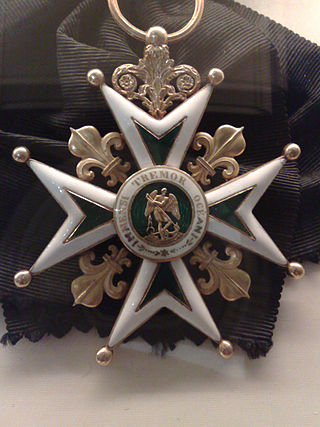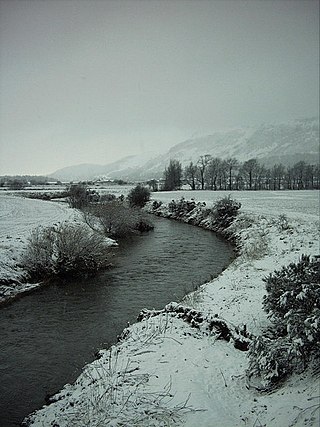
Francis II was King of France from 1559 to 1560. He was also King of Scotland as the husband of Mary, Queen of Scots, from 1558 until his death in 1560.

Mary of Guise, also called Mary of Lorraine, was Queen of Scotland from 1538 until 1542, as the second wife of King James V. She was a French noblewoman of the House of Guise, a cadet branch of the House of Lorraine and one of the most powerful families in France. As the mother of Mary, Queen of Scots, she was a key figure in the political and religious upheaval that marked mid-16th-century Scotland, ruling the kingdom as queen regent on behalf of her daughter from 1554 until her death in 1560.

Joanna of Bourbon was Queen of France by marriage to King Charles V. She acted as his political adviser and was appointed potential regent in case of a minor regency.
The Treaty of Edinburgh was a treaty drawn up on 5 July 1560 between the Commissioners of Queen Elizabeth I of England with the assent of the Scottish Lords of the Congregation, and the French representatives of King Francis II of France to formally conclude the siege of Leith and replace the Auld Alliance with France with a new Anglo-Scottish accord, while maintaining the peace between England and France agreed by the Treaty of Cateau-Cambrésis.

Madeleine of Valois was a French princess who briefly became Queen of Scotland in 1537 as the first wife of King James V. The marriage was arranged in accordance with the Treaty of Rouen, and they were married at Notre-Dame de Paris in January 1537, despite French reservations over her failing health. Madeleine died in July 1537, only six months after the wedding and less than two months after arriving in Scotland, resulting in her nickname, the "Summer Queen".

Alexander Stewart, Duke of Albany, was a Scottish prince and the second surviving son of King James II of Scotland. He fell out with his older brother, King James III, and fled to France, where he unsuccessfully sought help. In 1482 he invaded Scotland with the army of King Edward IV of England and assumed control of the country. Scottish lords turned against him in 1483 and he fled after King Edward died. The second invasion, in 1484, was not supported by the new English king, King Richard III, and failed. He died in a duel with Louis XII of France, Duke of Orléans, by a splinter from Louis's lance.
Thomas Spens [de Spens], Scottish statesman and prelate, received his education at Edinburgh, was the second son of John de Spens, custodian of Prince James of Scotland, and of Lady Isabel Wemyss.

The Lords of the Congregation, originally styling themselves the Faithful, were a group of Protestant Scottish nobles who in the mid-16th century favoured a reformation of the Catholic church according to Protestant principles and a Scottish-English alliance.

The Order of Saint Michael is a French dynastic order of chivalry, founded by King Louis XI of France on 1 August 1469, in response to the Order of the Golden Fleece founded by Philip the Good, Duke of Burgundy, Louis' chief competitor for the allegiance of the great houses of France, the dukes of Orléans, Berry, and Brittany. As a chivalric order, its goal was to confirm the loyalty of its knights to the king. Originally, there were a limited number of knights, at first thirty-one, then increased to thirty-six including the king. An office of Provost was established in 1476. The Order of St Michael was the highest Order in France until it was superseded by the Order of the Holy Spirit.
Metrophanes II served as Bishop of Cyzicus in Asia Minor when he was called to join the delegation of bishops attending the Council of Florence. He was appointed by the Emperor John VIII in May 1440 as successor to Patriarch Joseph II of Constantinople following the death of the latter in Florence. The Emperor was eager to secure help from Pope Eugene IV to deal with Turkish aggression, so he forced the patriarch and all other bishops to submit to papal authority. Only one bishop did not submit: Markos Eugenikos, Metropolitan of Ephesus, and without his signature the document of Union between East-West fell inactive. For his submission to the Union, he was nicknamed Mitrofonos (Mother-Killer). Metrophanes consecrated several unionist bishops and repeatedly pressed the Emperor John VIII to support the union openly. John finally agreed to summon a local council of bishops, but Metrophanes died before the council could meet.
James Bane was Bishop of St. Andrews for a brief period in the early 14th century. In his earlier career, James had been a canon of Aberdeen and prebendary of Cruden.

The Scots College was a college of the University of Paris, France, founded by an Act of the Parliament of Paris on 8 July 1333. The act was a ratification of an event that had already taken place, the founding of the Collegium Scoticum, one of a number of national colleges into which the University was divided. The Scots College came to an end in 1793 when the National Convention abolished the colleges and reorganized the University along different lines.

The Auld Alliance was an alliance between the kingdoms of Scotland and France against England made in 1295. The Scots word auld, meaning old, has become a partly affectionate term for the long-lasting association between the two countries. Although the alliance was never formally revoked, it is considered by some to have ended with the signing of the Treaty of Edinburgh in 1560.
The Battle of Skaithmuir was a skirmish of the First War of Scottish Independence. It took place near Coldstream, on the Anglo-Scottish border, in February 1316. The skirmish was fought between the Scottish captain Sir James Douglas, and an English raiding party from Berwick upon Tweed. The English were having difficulty getting supplies to Berwick after the Scots had won back the surrounding territory and the garrison was facing starvation. Under Edmond Caillou, a Gascon knight, about 80 men set out from Berwick to raid Teviotdale for cattle. Douglas, having been informed that there were fewer in the raiding party, set out to cut them off. Douglas won, and Caillou was killed. Douglas later called it the most difficult fight of his long career. The Scots under Douglas and Thomas Randolph went on to capture Berwick in April 1318.

The Rough Wooing, also known as the Eight Years' War, was part of the Anglo-Scottish Wars of the 16th century. Following its break with the Catholic Church, England attacked Scotland, partly to break the Auld Alliance and prevent Scotland being used as a springboard for future invasion by France, partly to weaken Scotland, and partly to force the Scottish Parliament to confirm the existing marriage alliance between Mary, Queen of Scots, and the English heir apparent Edward, son of King Henry VIII, under the terms of the Treaty of Greenwich of July 1543. An invasion of France was also contemplated. Henry declared war in an attempt to force the Scottish Parliament to agree to the planned marriage between Edward, who was six years old at the start of the war, and the infant queen, thereby creating a new alliance between Scotland and England. Upon Edward's accession to the throne in 1547 at the age of nine, the war continued for a time under the direction of the Duke of Somerset, before Somerset's removal from power in 1549 and replacement by the Duke of Northumberland, who wished for a less costly foreign policy than his predecessor. It was the last major conflict between Scotland and England before the Union of the Crowns in 1603.

Henri Cleutin, seigneur d'Oisel et de Villeparisis, was the representative of France in Scotland from 1546 to 1560, a Gentleman of the Chamber of the King of France, and a diplomat in Rome 1564–1566 during the French Wars of Religion.

Mary of Bourbon or Marie de Bourbon was a daughter of Charles, Duke of Vendôme, and Françoise d'Alençon, daughter of René, Duke of Alençon. Mary was the subject of marriage negotiations of James V of Scotland. He visited her in France, but subsequently married Madeleine of Valois. Mary died two years later.
The Treaty of Haddington was a treaty signed in 1548 between France and Scotland that promised Mary, Queen of Scots to Dauphin Francis in marriage in return for French assistance in the Siege of Haddington and subsequent French influence in Scotland. Mary, only six years old at the time, subsequently went to live in France, eventually marrying the Dauphin, while her regents ruled in her name in Scotland.
The County of Clermont-en-Argonne was a feudal domain in the Holy Roman Empire during the Middle Ages and in the Kingdom of France during the early modern period. It was centred on the fortified hilltop town of Clermont-en-Argonne in the diocese of Verdun. The term Clermontois can refer both to the region around Clermont and to the people of the town and region.
Events from the year 1631 in France











